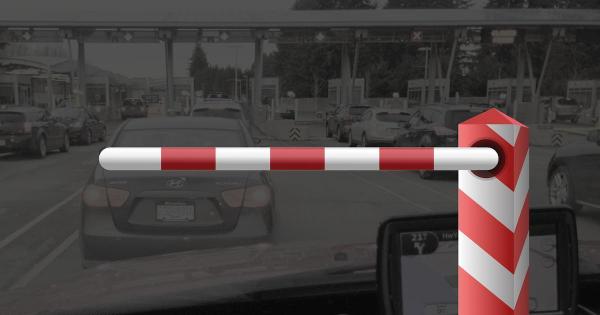
Sweden and Hungary classified as high-incidence areas – new obligations for drivers
Drivers who have spent 10 days in a high-incidence area before entering Germany are required to:
❎ destination traffic*: register before crossing the border. The digital form is available in many languages.
❎ to present a negative result of a Covid-19 test. Truck drivers are exempt from this requirement if their stay in Germany is shorter than 72 hours.
❎ Transit: No registration or negative test required.
*❗ Drivers who have spent less than 24 hours in these countries or who are going to spend less than 24 hours in Germany are exempt from the obligation to register.
The previous classification remains unchanged.

The schedule of HGV traffic restrictions in Tirol for the second half of 2021
The schedule prepared by the Austrian authorities includes 16 days when the number of trucks crossing the border at the Kufstein Nord from Germany will be limited.
Altogether, there are 35 days with scheduled restrictions in 2021 when a maximum of 300 trucks per hour will be able to cross the border .
The prime minister of Tyrol, Günther Platter, has emphasized that the schedule for the second half of the year was established on the basis of experiences from previous years, taking into account days when there is a high risk of a traffic collapse. The limiting of the number of incoming trucks prevents dangerous situations at transport hubs and ensures the safety of traffic and supplies. Therefore, the Austrian authorities intend to apply this solution.
In 2018, there were 27 days of HGV traffic restrictions, and in 2019 – 35 days. In 2020, due to a decline in morning traffic peaks as a result of the pandemic, the measure was only applied on 24 of the 35 scheduled days.
As government spokesman Ingrid Felipe explained, the main purpose of the schedule is to identify days with heavy morning peaks at the Kufstein crossing which, when combined with the overall heavy traffic on the A12 in the Inn valley or on the A13 via the Brenner Pass, cause huge disruptions. Depending on the traffic situation at a given time, the scheduled measure can be cancelled. In 2020, the average daily length of the restriction was four hours. Of course, the heavy traffic volume in the Brenner Corridor will continue to be closely monitored.
The analysis of restrictions imposed in the past years has shown that the accuracy of the forecasted critical days is very high. On the whole, using past empirical values and taking into account traffic projections, the planners did not make any abrupt changes or introduced any additional days in the schedule.
The schedule for the second half of 2021:
July 5 – Monday
July 12 – Monday
July 19 – Monday
July 26 – Monday
October 27 – Wednesday after the Austrian National Day
November 2 – Tuesday (after All Saints Day)
November 3 – Wednesday
November 10 – Wednesday
November 17 – Wednesday
November 24 – Wednesday
December 1 – Wednesday
December 2 – Thursday
December 9 – Thursday (the day after the Solemnity of the Immaculate Conception of the Blessed Virgin Mary)
December 13 – Monday
December 14 – Tuesday
December 15 – Wednesday.
More detailed information in the links below:
19 dni z ograniczeniami dla ciężarówek
Tyrolskie blokady czyli wielokilometrowe korki i utrudnienia dla kierowców

No more testing for lorry drivers entering France
From March 5, drivers going directly from Ireland to France are no longer obliged to present a negative Covid-19 test.
The Irish Department of Transport has been informed that the French Government will no longer require drivers of Heavy Goods Vehicles (HGV), Light Goods Vehicles (LGV) or Coaches travelling on direct maritime routes from Ireland to France to present proof of a negative COVID-19 antigen or PCR test. Neither are they required to provide a “declaration of honour”.
Testing sites are still open and drivers can perform free tests, which are still required, for example, when entering Germany or the Netherlands.
IRELAND
Listed below are testing sites where drivers can take a free test:
❎Dublin site, located south of Dublin Airport in the part of what was previously Dublin Airport’s Blue Long Stay Car Park, signposted from M1 Junction 2 (Airport) and M50 Junction 4 (Ballymun). https://goo.gl/maps/FijbUu8wy8PbBy7x5
❎ Gorey Motorway Service Area (Circle K), located just off the M11 motorway, at a purpose-built junction between junctions 21 and 22, 78 km from Rosslare Europort. https://goo.gl/maps/FijbUu8wy8PbBy7x5
❎Holmestown Civic Amenity Facility, located at the Holmestown Waste Management facility, 650m from the N25 in Holmestown, County Wexford. Eircode – Y35 Y28W. The site is 27 km from Rosslare Europort. https://goo.gl/maps/hQB2LSdmV6vUqjZe8
❎ Cork Airport is an option to facilitate sailings from the Port of Cork and drivers in the Munster area. Follow signage on airport approach. Parking facilities for HGVS at the Airport are now in place. Pre-booking is mandatory at this facility.

Slovenia has divided and closed border crossings
From March 8 the Slovenian border can be crossed at several checkpoints, divided into categories A and B.
Category A includes checkpoints which are open 24/7. Border crossings classified as category B may be used by persons included in Art. 10 * of the regulation which sets out exceptions, including professional drivers.
✅ Checkpoints at road connections in the border area with Italy
Category A checkpoints:
• Vrtojba
• Fernetiči
• Škofije.
Category B checkpoints:
• Krvavi potok (from 5:00 a.m. to 11:00 p.m.)
• Robič (from 5:00 a.m. to 11:00 p.m., closed on Sundays and public holidays)
• Predel (from 6:00 to 9:00 a.m. and from 3:00 to 6:00 p.m., closed on Sundays and public holidays)
• Nova Gorica (Erjavčeva street) (from 6.00 a.m. to 9.00 p.m.)
• Neblo (from 7.00 to 9.00 a.m. and from 4.00 p.m. to 7.00 p.m.)
• Rateče (between 6:00 a.m. and 9:00 p.m.).
✅ Checkpoints at road connections in the border area with Austria
Category A checkpoints:
• Karavanke
• Ljubelj
• Šentilj (avtocesta)
• Gornj Radgon
• Gederovci.
Category B checkpoints:
• Holmec (between 5:00 a.m. and 11:00 p.m.)
• Vič (between 5:00 a.m. and 11:00 p.m.)
• Šentilj – motorway (from 5:00 to 7:00 a.m. to 5:00 to 7:00 p.m.)
• Trate (from 5:00 to 8:00 a.m. and from 4:00 to 8:00 p.m.)
• Yuri (from 5:00 to 8:00 a.m., from 4:00 to 7:00 p.m.)
• Kuzma (from 4 to 11 p.m.).
✅ Checkpoints at road connections in the border area with Hungary
Category A checkpoints:
• Dolga vas
• Pince (motorway).
Category B control points are:
• Hodoš (from 6 to 8 a.m., from 2 to 3 p.m. and from 7 to 8 p.m.)
• Čepinci (from 6.00 to 8.00 a.m. and from 2.00 to 4.00 p.m.).
* ❗❗ Entry without a negative test result and quarantine is allowed in the following cases, as stated in article 10 of the regulation setting out the expcetions:
• International transport drivers with an internationally recognized certificate of qualification sufficient to certify that the driver provides international transport services; in the absence of such a certificate, a certificate signed by the employer is sufficient.
• International transport drivers delivering goods to / from Slovenia or transporting people on condition that they leave the territory of the RSI within 8 hours.
• People in transit, provided they leave the territory of the RSI within 6 hours. This means that the person has to leave Slovenia within this time and the passage through the territory of Slovenia must be made without unnecessary stops or leaving the transit route. During the transit journey, drivers are allowed to make necessary stops, e.g. to refuel or use the bathroom. Overnight stay is not allowed.
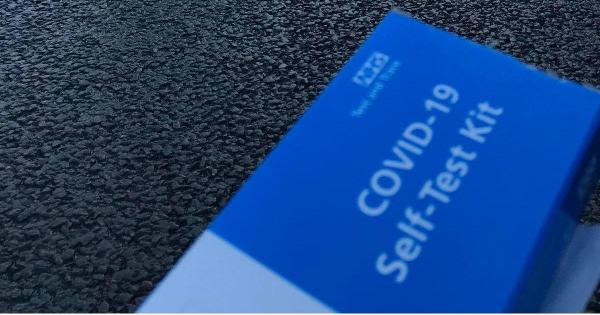
Suspension of haulier services at Manston announced
A significant step towards normality on Kent’s roads is being taken with the suspension of services for EU-bound HGVs at the former Manston Airport site.
From Sunday 21 March 2021 freight heading for the Port of Dover will no longer be directed to attend the Department for Transport-owned site, which will no longer offer Covid-19 tests or customs checks but can be reactivated at short notice if necessary.
All HGVs will instead access the Operation Brock traffic management system between Junctions 8 and 9 on the M20 coastbound carriageway, with one lane being used for Eurotunnel and the other for the Port of Dover. Any HGVs that attempt to take an alternative route outside of Brock risk enforcement action being taken against them.
HGV drivers who require a Covid-19 test before leaving the UK are strongly encouraged to take one before entering Kent in order to avoid delays. Any that arrive without one will now be directed to a single facility at Sevington, near Ashford.
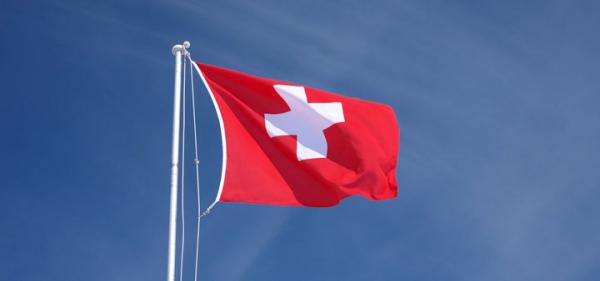
Obligatory quarantine in Switzerland – what about drivers?
From March 22, Poland will be included in the Swiss list of countries and areas with an increased risk of infection.
Anyone who has stayed in a high-risk country or region in the last 10 days is obliged to report this fact to the cantonal authorities after arriving in Switzerland and go into quarantine, regardless of their citizenship.
The following persons are exempt from the testing and quarantine requirement:
• people travelling on business for an important reason that cannot be postponed.
• People travelling for an important medical reason that cannot be postponed.
• Transit passengers who have spent less than 24 hours in a state or area with an increased risk of infection.
• Transit passengers who enter Switzerland for the purpose of transiting the country.
• People who in the course of their professional activities transport passengers or goods across borders.
Exemptions from the testing requirement apply when crossing the border, but not when boarding an aircraft. The list of countries and areas with an increased risk of infection is compiled by the Federal Office of Public Health and regularly updated.

Spain: exceptional suspension of HGV driving bans
By virtue of the resolution issued on 25 January, the General Directorate of Traffic has decided to suspend of the bans on account of the situation related to the epidemic crisis.
As a result, driving restrictions for heavy goods vehicles with a maximum permissible weight of over 7.5 tons, vehicles requiring an additional permit and special vehicles listed in Annex II to the resolution will be suspended from Thursday (18 March) until and including Sunday (21 March).

❗ Poland on the German list of international risk areas – new requirements for drivers
Since Sunday, March 21, Poland has been on the list of areas with a high incidence of Covid-19.
Germany classifies countries into three groups: high incidence areas, risk areas and areas of variant of concern. Depending on the designation, there are different requirements for HGV drivers, which are presented below.
Germany classifies countries into three groups: high incidence areas, risk areas and areas of variant of concern. Depending on the designation, there are different requirements for HGV drivers, which are presented below.
❗ Poland has been included in the group of countries designated as high incidence areas, together with Bulgaria and Cyprus. This is associated with new requirements for drivers. Details below ⬇
1. High incidence areas
Drivers who within 10 days before entering Germany have visited a “high frequency area” (❗i.e. Poland) are required to:
❎ for destinations in Germany: register before entering. The digital form is available in many languages. www.einreiseanmeldung.de
❎ present a negative result of a COVID-19 test: drivers are exempt from the test requirement as long as they have only spent 72 hours in a high-incidence area or they are going to stay in Germany for only 72 hours.
* ❗ People who commute to work every day, i.e. those who stay abroad for less than 24 hours or enter Germany for a period of up to 24 hours, are exempt from the obligation to register.
2. Risk areas
Requirements for drivers who within 10 days before entering Germany have visited a “risk zone”:
❎ drivers going to destinations in Germany are not required to register before entering the country
❎ a negative test result is not required
❎ Transit: No registration or negative test required.
3. Areas of variants of concern
Drivers who within 10 days before entering Germany have visited an “area of variant of concern” (France – Moselle department, Slovakia, Czech Republic) are required to:
❎ for destinations in Germany: register before entering. The digital form is available in many languages. www.einreiseanmeldung.de
❎ present a negative result of a COVID-19 test:
There are no exceptions to the above requirement for those who within 10 days of enetering Germany have come stayed in or arrived from areas where new virus variants have appeared. People who are professionally involved in transporting people or goods across borders by road, rail, ship or plane are therefore obliged to undergo a test and present a negative test result upon entry.

Up to EUR 25,000 fine for violating the registration and testing requirements when entering Germany
Since Poland was designated as a high incidence area, on Sunday, March 21, Germany has introduced a number of restrictions that also affect international transport drivers.
The system for monitoring the spread of COVID-19 for people ENTERING Germany relies on two measures: the obligation to register and the testing requirement. There are, however, a number of exceptions.
The REGISTRATION OBLIGATION does not apply to persons:
1. making a transit journey only (without stops),
2. who have made a transit journey through Poland or another high incidence area,
❗NOTE! From 21 March, drivers entering Germany from Poland must carry an registration form obtained from einreiseanmeldung.de (except for the two cases above).
THE TESTING REQUIREMENR does not apply to:
➡ professional drivers involved in the transport of people / goods, provided that their stay in Germany lasts less than 72 hours or, if they have stayed in a high incidence area (Poland) for up to 72 hours; NOTE – Mecklemburg – Vorpommern requires the test in EVERY CASE; DETAILS HERE
➡ drivers passing through Germany in transit,
➡ drivers entering from a high incidence area (including Poland), which they only passed in transit. Random border checks of compliance with entry requirements can be conducted, also in the case of professional drivers (recently such checks have performed almost continuously at the crossings at Słubice, Rosówek and Lubieszyn). Fines for violating the registration obligation or the test requirement can be up to EUR 25,000.
FREQUENTLY ASKED QUESTIONS:
1. I travel to Germany several times a week – how long is my Covid test valid?
When entering Germany, you must be able to show a certificate of a negative test result (in English or German) which is not older than 48 hours (counting from the moment when the sample was taken not when the certificate was issued).
2. I am going to the Netherlands via Germany and picking up a cargo in Germany on the way back – do I have to take a test?
No, drivers entering from the Netherlands, which is not a high incidence area, do not need a test, but must carry a proof of registration.
3. Yesterday I took a test before entering Germany and today I am in Austria. In the evening I’m driving back to Germany from Tyrol. Do I need to take another test?
There is no obligation to retake the Covid test if the previous negative test result was obtained no more than 48 hours before entering Germany.
4. Am I exempt from the testing requirement when entering Germany outside Mecklemburg-Vorpommern (Słubice, Krajnik Dolny, Kostrzyn nad Odrą) if my stay in Germany is shorter than 72 hours?
Yes, when driving outside Mecklemburg-Vorpommern, there is no obligation to take a test if your stay in Germany is shorter than 72 hours. BUT if you enter this state from another side you are still have to take a test.
5. Do I also have to take a test when entering Germany from other countries?
Drivers are only obliged to take a test when entering from high incidence areas and areas of variants of concern, which includes Poland, Sweden (persons arriving by ferry must have already been tested), Austria (Tyrol), Slovakia and Czech Republic.
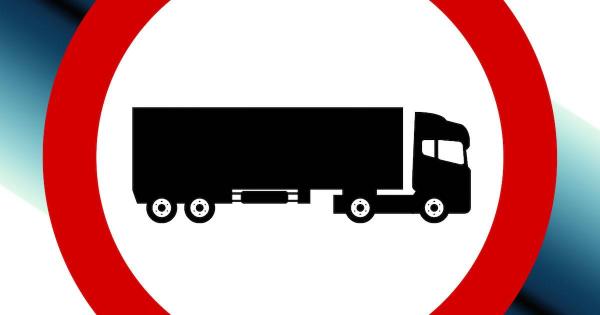
Four EU countries suspend holiday HGV driving bans
The suspension has been introduced by Slovakia, Italy, Germany and Spain in connection with the pandemic.
SLOVAKIA
At the request of the Slovakian road transport association ČESMAD, a general exemption from the HGV driving ban has been granted on April 2 and 5 in connection with the Easter holidays. The exemption applies to all HGVs traveling on motorways, roads for motor vehicles, class I roads and roads with international traffic, arriving in Slovakia from some neighbouring countries and heading for destinations (e.g. company headquarters or place of unloading) located within Slovakia.
ITALY
The Italian Ministry of Transport has once again lifted the driving ban for vehicles with a total weight of over 7.5 tons by virtue of a ministerial decree issued on March 23.
This means that on March 28 and from April 2 to 6 HGVs with a MAM of 7.5 tons will be allowed to drive on non-urban roads.
The decision has been motivated by the coronavirus crisis and the need to improve the transport system and traffic flow.
GERMANY
This year, the federal states have also lifted the driving ban on Sundays and public holidays in accordance with Section 30 (3) of the German Road Traffic Regulations (StVO) by means of general exemption orders for all Easter holidays, so that there is no driving ban for the entire period from Maundy Thursday to Easter Monday inclusive.
The general exemption generally covers all transports as well as empty runs. Due to further lockdown extensions, the federal states have also extended their general exemptions until April 05, 2021 (Lower Saxony, Saxony-Anhalt, Baden-Württemberg, Schleswig-Holstein, Brandenburg, Hesse, Berlin and Rhineland-Palatinate until June 30, 2021). Details in the table below:
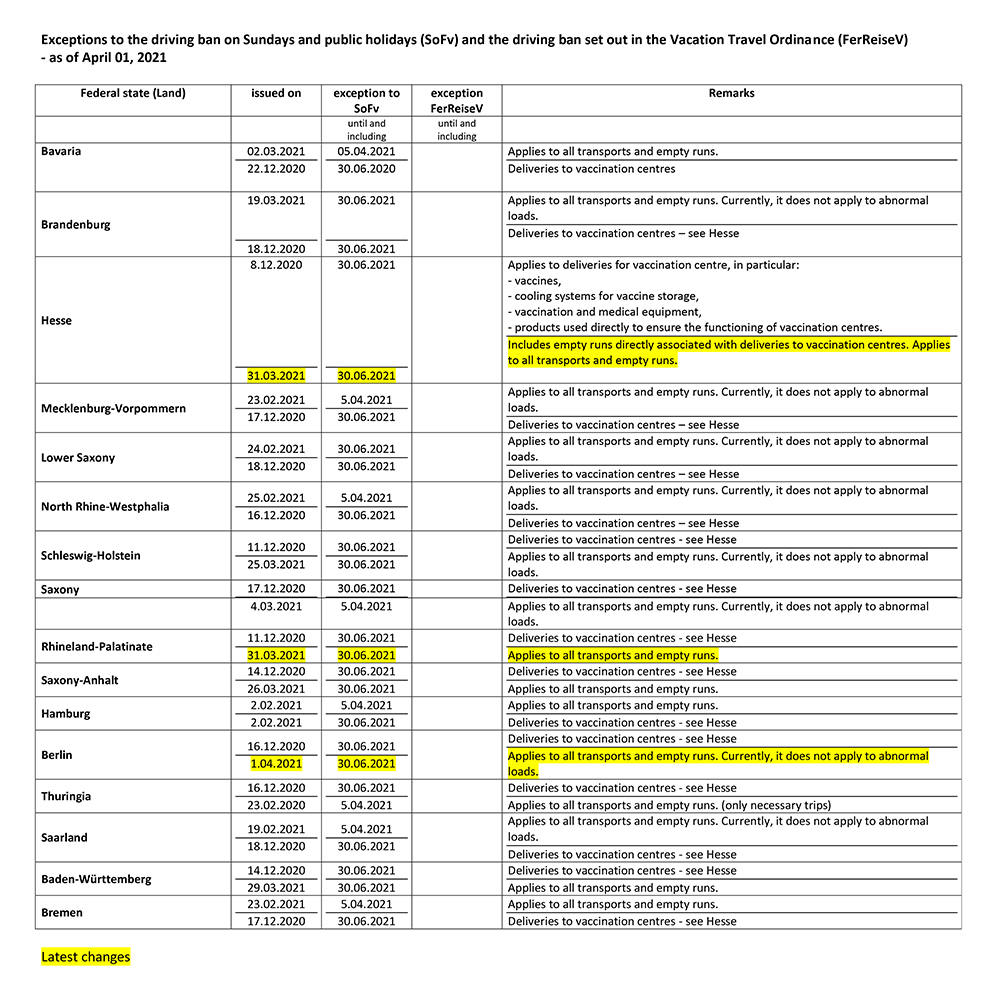
SPAIN
The new resolution on HGV traffic restrictions in 2021 was published on 25 January. Taking into account traffic restrictions introduced in the Autonomous Communities and approved by the Interterritorial Health Council for the period of the Holy Week, the General Directorate of Traffic has once again agreed to suspend from Friday 26 March to Monday 5 April restrictions that apply to vehicles with a MAM of more than 7.5 t, special vehicles and vehicles requiring an additional permit, following the example of the Basque Country, where similar exceptions have also been introduced. A similar suspension is also likely to be approved by the Catalonian Traffic Directorate.
However, these temporary exemptions will not affect restrictions on special transports performed at weekends and to vehicles carrying dangerous goods, i.e. those listed in part B.2.2 or to the general and specific restrictions set out in Annex V of the resolution of 25 January.
The suspension will also not apply to roads leading to the French border on the following sections and dates:

SLOVENIA
Despite the decree extending the state of epidemic emergency in the country until April 16, introducing an exemption from the driving ban for all HGVs and vehicle combinations with a MAM of over 7.5 tons in the period from March 18, 2021 to April 16 between 8 a.m. to 9 p.m., the state authorities have decided to reintroduce restrictions during the Easter holidays.
❗ Regardless of the general suspension of the HGV driving ban in the period from March 18 to April 16, the exemption does NOT apply during the Easter period, i.e. from 3 to 5 April inclusive.